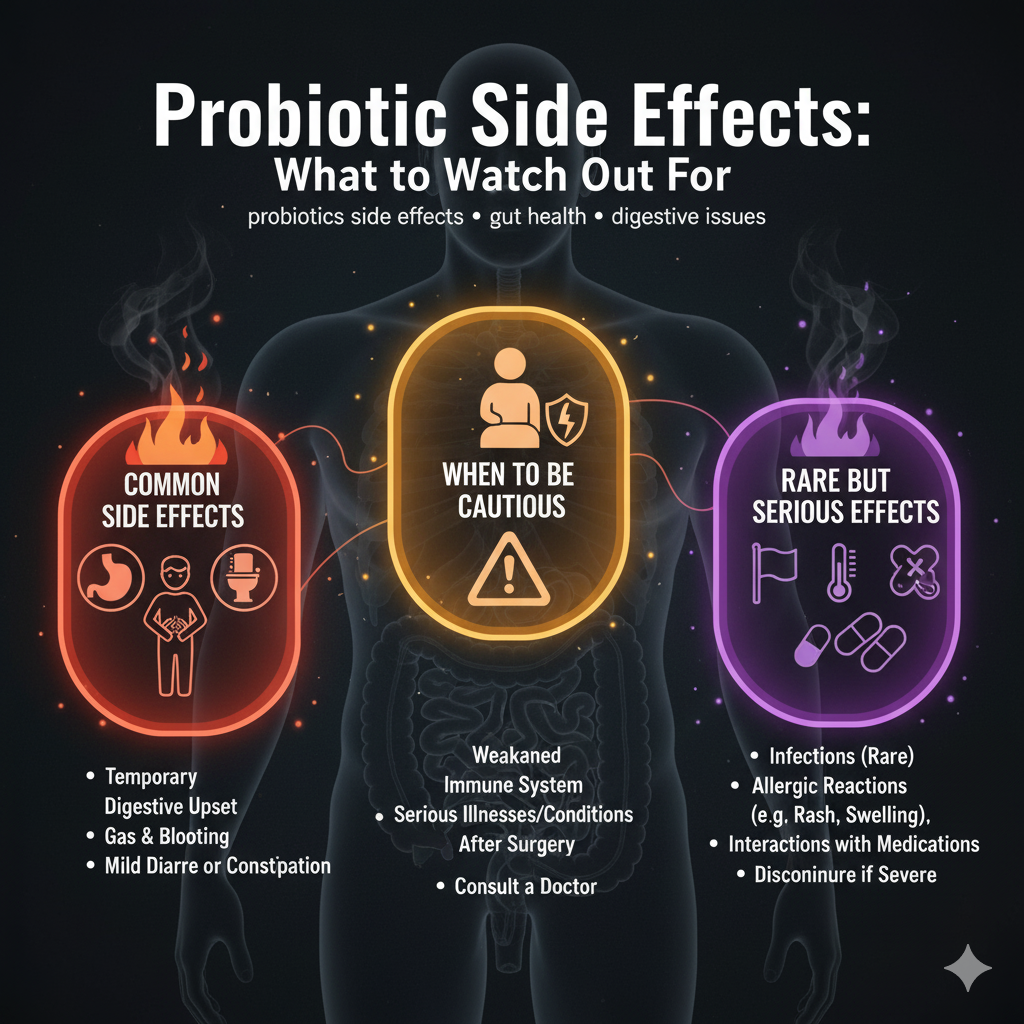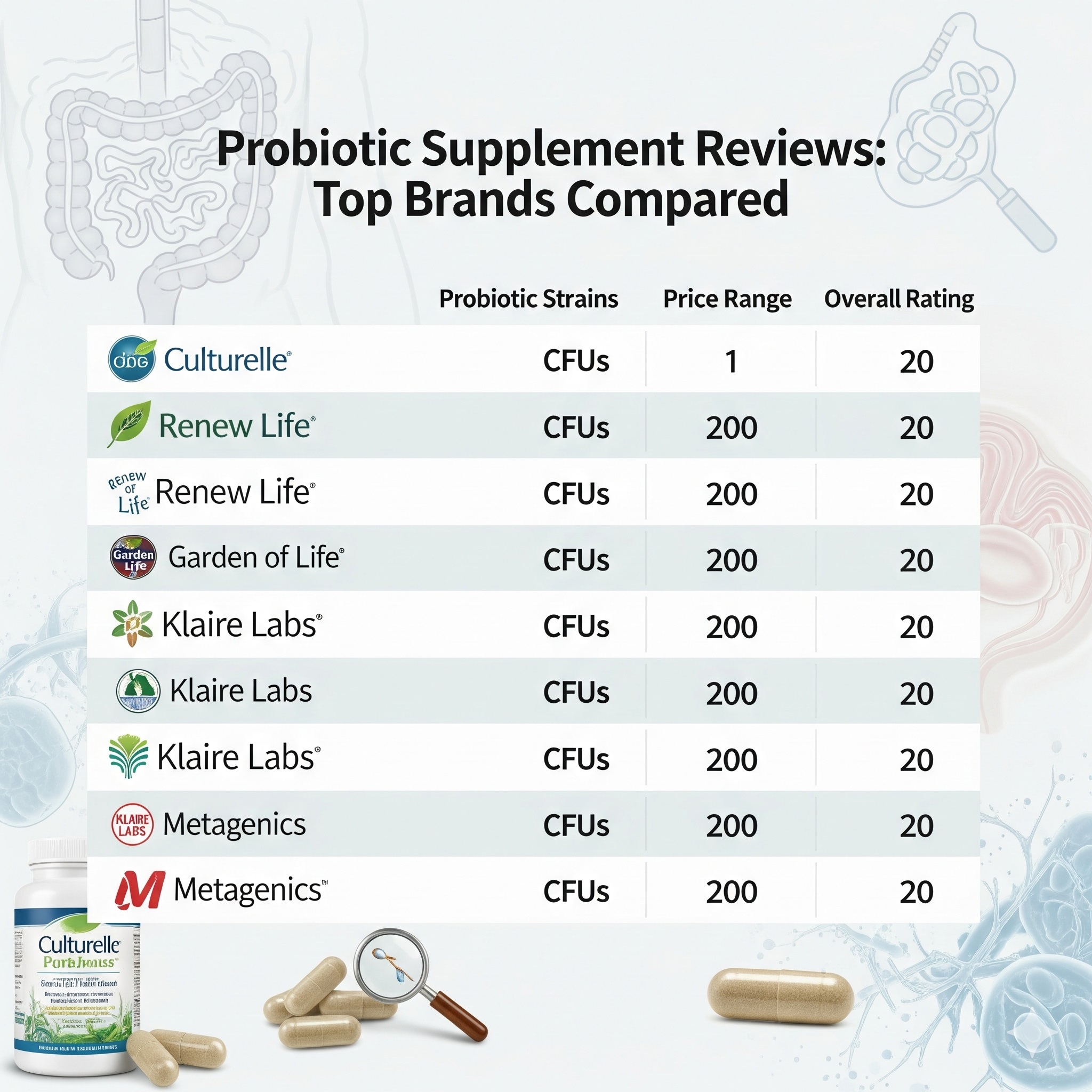Probiotics are widely praised as one of the most beneficial supplements for gut health. They are live microorganisms — mainly bacteria and yeasts — that can support digestion, immunity, and even mood when taken in the right amounts. They are found naturally in fermented foods like yogurt, kefir, sauerkraut, kimchi, and kombucha, as well as in capsule or powder supplements.
But while most people tolerate probiotics well, they are not completely risk-free. Like any biologically active compound, probiotics can produce side effects — particularly when you start taking them for the first time, take them in very high doses, or have certain health conditions. Understanding these potential side effects can help you use probiotics safely and effectively.
This article explores the most common probiotic side effects, explains why they occur, and provides strategies to minimize them.
Why Side Effects Happen
Before discussing specific side effects, it helps to understand what probiotics actually do inside your gut.
Your gastrointestinal tract is home to trillions of bacteria collectively known as the gut microbiome. Probiotics are thought to work by:
- Restoring balance in the microbiome after it’s been disrupted (e.g., by antibiotics, illness, poor diet).
- Producing beneficial compounds like short-chain fatty acids (SCFAs).
- Competing with harmful microbes for nutrients and space.
- Interacting with your immune system to reduce inflammation.
When you suddenly introduce large numbers of new bacteria or yeast, your gut ecosystem must adapt. This temporary imbalance can create symptoms as your microbiome “shifts” to a new equilibrium.
Additionally, probiotics are live organisms — so depending on your health status, immune system, and the strains you choose, there may be risks beyond mild digestive upset.
Common Short-Term Side Effects
Most side effects are mild, temporary, and resolve within a few days to a couple of weeks as your body adjusts.
1. Gas and Bloating
This is the most commonly reported side effect. When probiotics ferment carbohydrates in the intestines, they release gas as a byproduct. This can lead to bloating, flatulence, and a sense of fullness.
- Why it happens: Rapid changes in gut microbiota produce temporary fermentation imbalances.
- How to minimize: Start with a lower dose and gradually increase over one or two weeks. Take probiotics with meals to buffer stomach acid and improve survival.
2. Mild Diarrhea or Loose Stools
Some people experience increased bowel movements or mild diarrhea shortly after starting probiotics.
- Why it happens: The microbiome may shift motility (movement of the intestines) and water balance.
- How to minimize: Drink plenty of fluids to avoid dehydration. Reduce the dose until stools normalize, then slowly build back up.
3. Constipation
Surprisingly, the opposite can also happen — some people experience temporary constipation.
- Why it happens: Certain probiotic strains (like Lactobacillus acidophilus) may slow gut motility before they improve it, especially if the gut was previously dysregulated.
- How to minimize: Stay hydrated, eat plenty of fiber, and consider a multi-strain probiotic with bifidobacteria (e.g., Bifidobacterium lactis), which tend to promote regularity.
4. Abdominal Cramps
Cramping is usually related to gas buildup or changes in gut muscle contractions.
- How to minimize: Introduce probiotics gradually, pair them with prebiotics for smoother adaptation, and avoid excessive intake of fermentable carbohydrates during the first few days.
Less Common but Notable Side Effects
While rare, some people may experience more significant issues, especially if they are sensitive or immunocompromised.
5. Skin Rashes or Itching
Occasional allergic reactions or histamine responses can cause rashes, itching, or flushing.
- Why it happens: Some probiotic strains produce histamine as part of their metabolism, which may trigger symptoms in histamine-intolerant individuals.
- What to do: Discontinue use and consult a healthcare professional if symptoms are persistent or severe. Look for low-histamine probiotic strains such as Bifidobacterium infantis or Lactobacillus plantarum.
6. Headaches
A small subset of people report headaches after consuming probiotics, particularly those in fermented foods.
- Why it happens: Histamine, tyramine, and other biogenic amines produced during fermentation can dilate blood vessels and trigger headaches in sensitive individuals.
- Solution: Choose supplements instead of fermented foods if this is a problem, or opt for strains with minimal histamine production.
7. “Die-Off” Symptoms
Some users experience fatigue, brain fog, or flu-like symptoms after beginning probiotics.
- Why it happens: This is sometimes attributed to a “die-off” reaction (Jarisch-Herxheimer reaction) when harmful bacteria are killed off, releasing endotoxins that briefly stress the body.
- How to manage: Reduce dose, stay hydrated, get adequate rest, and allow your system time to adapt.
Potential Risks for Certain Populations
For most healthy adults, probiotics are very safe. However, certain groups should be cautious:
- Immunocompromised individuals: People with HIV/AIDS, cancer, or those on immunosuppressive medications may be at risk of bloodstream infections (bacteremia or fungemia) from probiotics.
- Critically ill or hospitalized patients: Rare cases of sepsis linked to probiotics have been reported, usually in ICU settings.
- Infants or premature babies: Probiotics are sometimes given to neonates, but only under medical supervision due to risk of bloodstream infection.
- Those with central venous catheters: There is a rare risk of catheter contamination and systemic infection from probiotic organisms.
If you belong to one of these categories, always consult a healthcare provider before starting probiotics.
Drug Interactions
Probiotics generally have few interactions, but there are some considerations:
- Antibiotics: Antibiotics can kill probiotic bacteria if taken at the same time. Space probiotics at least 2–3 hours away from antibiotics.
- Immunosuppressants: May increase risk of systemic infection.
- Antifungals: Can inactivate yeast probiotics like Saccharomyces boulardii if taken simultaneously.
How to Minimize Side Effects
Here are practical steps to ensure a smooth experience with probiotics:
- Start Low and Go Slow
Begin with a low dose (e.g., one capsule every other day) and increase gradually over 1–2 weeks. - Choose the Right Strains
Research shows that different strains serve different purposes. For example, Bifidobacterium infantis may help with IBS, while Lactobacillus rhamnosus GG is useful for antibiotic-associated diarrhea. Choosing the wrong strain might not only be ineffective but can worsen symptoms. - Take Them at the Right Time
For many people, taking probiotics with a meal — especially one containing fat — improves survival through stomach acid. - Stay Hydrated
Adequate water intake helps manage changes in stool consistency. - Give Your Gut Time to Adjust
Mild gas and bloating are normal for the first few days. Stick with it unless symptoms are severe. - Pair with Prebiotics
Prebiotic fibers (like inulin, FOS, resistant starch) help feed the beneficial bacteria and promote colonization, which may reduce long-term digestive discomfort.
When to Seek Medical Help
You should contact a healthcare professional if you experience:
- Severe or persistent diarrhea
- High fever or chills
- Blood in stool
- Severe abdominal pain
- Rash, swelling, or difficulty breathing (signs of allergy)
- Symptoms that worsen instead of improve over time
The Bottom Line
Probiotics can be a powerful ally in promoting gut health, but they are not completely free from side effects. Most reactions are mild and temporary, including gas, bloating, and changes in bowel habits. However, more serious complications — while rare — can occur in vulnerable populations.
Choosing the right strains, introducing them gradually, and paying attention to your body’s response are key to minimizing side effects. As with any supplement, consult with a healthcare professional if you have chronic health conditions, are immunocompromised, or take prescription medications.
By taking a thoughtful, evidence-based approach, you can reap the digestive and immune benefits of probiotics while keeping unwanted side effects to a minimum.




